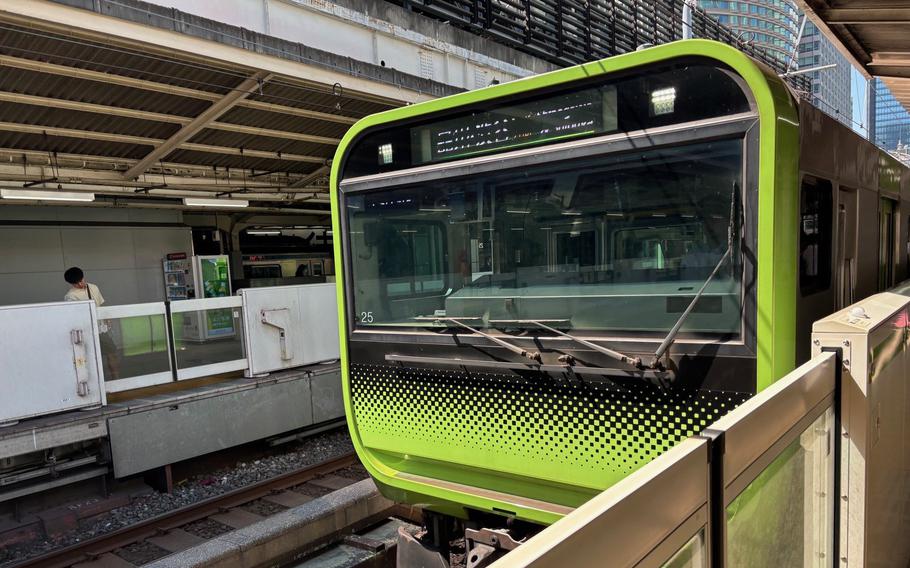
(Photo by Takahiro Takiguchi)
Exploring Tokyo with its many streets, buildings and attractions without getting lost may seem like a large feat to undertake alone. Fortunately, the city’s intricate public transportation system is well organized and easy to use with apps like Google Maps.
For newcomers and seasoned transplants alike, I recommend taking some time to get familiar with the JR Yamanote Line, as it runs in a circle around Tokyo’s center. A Yamanote train completes a loop in one hour, either clockwise (sotomawari) or counterclockwise (uchimawarai), on its 34.5-kilometer-long rail. The line is also known as the Tokyo Green Line and has stops along major stations like Tokyo Station, Shinjuku, Shibuya, Shinagawa, Ueno and Ikebukuro.
A quick ride on the Yamanote can take you to many of Tokyo’s famous attractions like the Imperial Palace, Ueno Zoo, Shibuya Crossing and Takeshita Street.
The line runs from 4:30 a.m. to 1 a.m. daily, so you have plenty of time to explore the entire loop around the center of Tokyo.
Are you lost in Tokyo? Look for one of the 30 Yamanote Line stations and hop on to get back on track to your destination. Even if you’re heading in the wrong direction, the trains stop every two to five minutes, allowing riders to quickly correct their route.
Each station on the Yamanote Line has some point of interest, so if you’re unsure of where to go next, you know a Green Line train will take you somewhere cool!
Yamanote Line Trivia
Beginning of operation: 1885
Total number of Stations: 30
Total length of service: 34.5 km (21.4 miles)
Total riding time (1 loop): 59 minutes (both inner and outer cycles)
Number of cars on a train: 11
Number of services: Once every 3-5 minutes (daytime)
Line Color: light green (The current light-green cars were introduced to Yamanote Line in 1963. Before that time, brown cars were used 1950-1955 then orange and yellow cars used till 1963.
Name: Yamanote-sen (There were two names, “Yamanote-sen” and “Yamate-sen” before the National Railway Company (former JR) determined “Yamanote-sen” as the official name of train service in 1971.)
Oldest station on the line: Shinagawa (1872)
Newest station on the line: Takanawa Gateway (2020)
– Source: All about and Fun! Japan
Stations on Yamanote Line
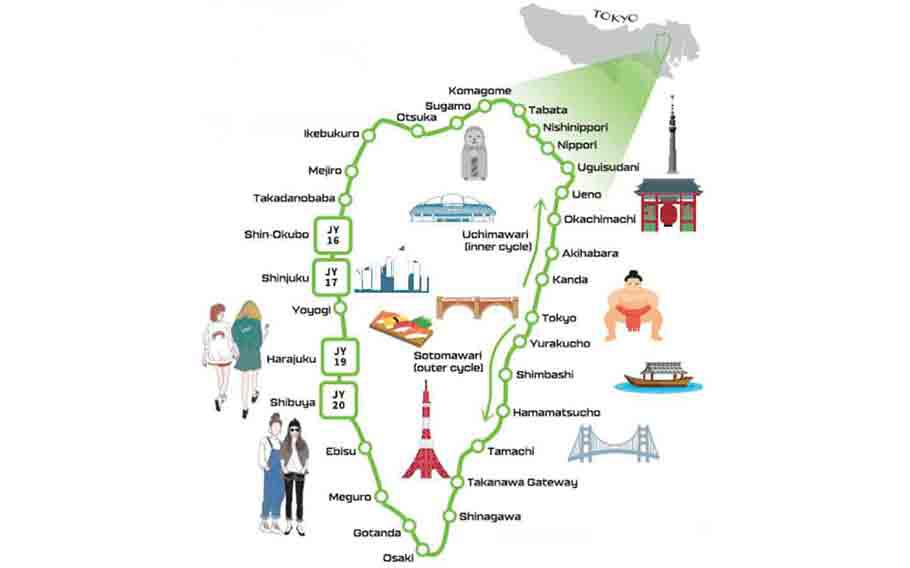
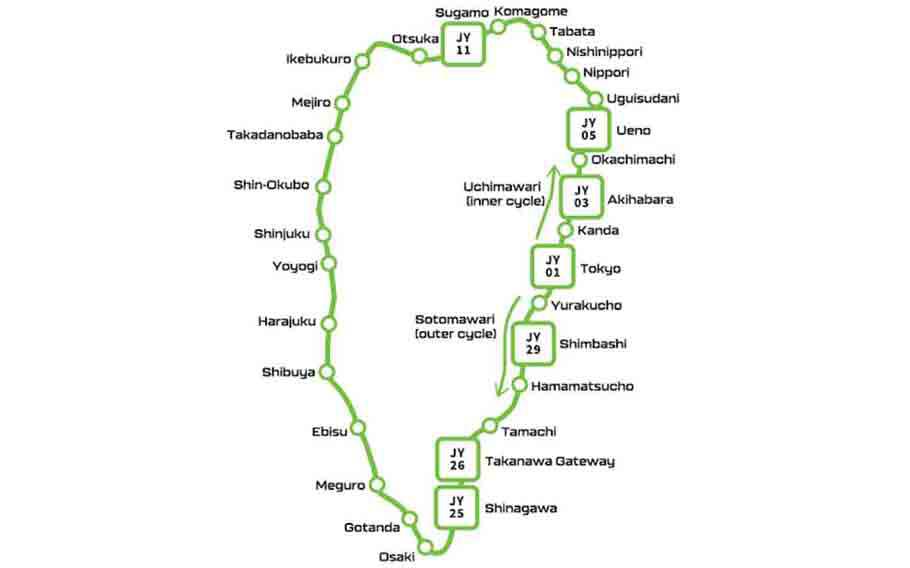
Shinjuku, JY 17 – Watch video
Shinjuku Kabukicho (Photo by Takahiro Takiguchi)
Toho Cinemas in Shinjuku Kabukicho (Photo by Takahiro Takiguchi)
Tokyo Metropolitan Government Building (Photo by Takahiro Takiguchi)
Omoide Yokocho (Photo by Takahiro Takiguchi)
Shinjuku Station is known as one of the busiest in the world, with Guiness World Records documenting 3.5 million passengers per day. In the eastern part of Shinjuku, you will be overwhelmed with bizarre and fantastical ambiance consisting of flashy bars, restaurants, karaoke, clubs, arcades, shops and movie theaters. Down the street, an enormous Godzilla bus looms over Kabukicho District from the terrace of Toho Cinema. The area is also home to arcades, music halls, restaurants, izakaya and Tokyo Kabukicho Tower, an entertainment complex. The western part of Shinjuku is known as a hustle-bustle business district of urban sub-center, home to numerous skyscrapers. Forty-nine skyscrapers in this district tower over 100 meters (320 ft.) or higher, and of those, 10 rise over 200 meters.
Shibuya, JY 20 – Watch video
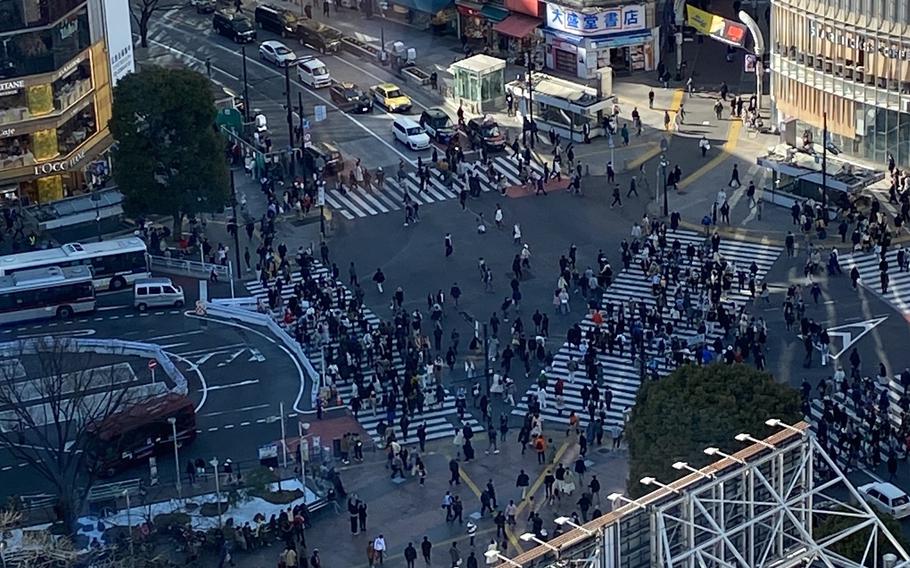
Shibuya Crossing (Photo by Takahiro Takiguchi)
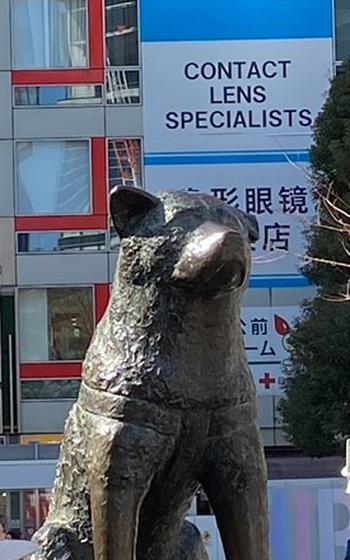
Statue of Hachi (Photo by Takahiro Takiguchi)
Shibuya Crossing is one of the most iconic cityscapes in Tokyo. Like New York City’s Times Square, this “scramble” is a popular meeting spot for locals and tourists alike. Try joining the surging wave of people using the unique intersection outside Shibuya Station every two minutes! Shibuya district is considered the epicenter of modern Japanese culture and is famous for good shopping, many restaurants, nightlife and “Hachi,” the loyal Akita dog ever waiting for his human to return. The iconic building of Shibuya 109 is home for the latest fashion for teenagers, while Seibu and Shibuya Mark City cater to the older, more sophisticated crowd.
Harajuku, JY 19 – Watch video

Takeshita St. (Photo by Takahiro Takiguchi)

Harajuku Station (Photo by Takahiro Takiguchi)
Takeshita-dori is one of the busiest shopping areas in Tokyo. The 350-meter street is brimming with tapioca tea and crepe joints and fashion boutiques. Young people and tourists flock to this area for kawaii (cute) accessories and souvenirs. Takeshita was once the epicenter of Tokyo’s new pop-culture and has been influential overseas. Midway through the madness, is another spot steeped in Japan’s history. Togo Jinja, a Shinto shrine, is dedicated to the memory of Admiral Heihachiro Togo. During the Russo-Japan War from 1904-1905, Togo and his combined fleet led Japan to victory by destroying 34 of Russia’s 38 warships in the Battle of Tsushima. Today, the shrine is a stop for those seeking success in business, in competition or examinations.
Shin-Okubo, JY 16 – Watch video
Shin-Okubo (Photo by Takahiro Takiguchi)
Shin-Okubo (Photo by Takahiro Takiguchi)
Also known as Tokyo’s Korea Town, Shin-Okubo is home to Korean restaurants and shops that line the main road. At Korean supermarkets, such as Seoul Market, you can buy many ingredients and cookware to create delicious Korean food at home. With the popularity of Korean movies and K-pop music, Shin-Okubo continues to grow in size and popularity. In the center of Shin-Okubo, there is Kaichu Inari, a Shinto shrine with an interesting legend. According to local lore, an Edo Era (1603-1867) sniper worshipped at this shrine and never missed his target when shooting his rifle. Since then, the shrine has become a place for those seeking luck in games, gambling and competitions.
Tokyo, JY 01 – Watch video
Tokyo Station (Photo by Miyuki Takiguchi)
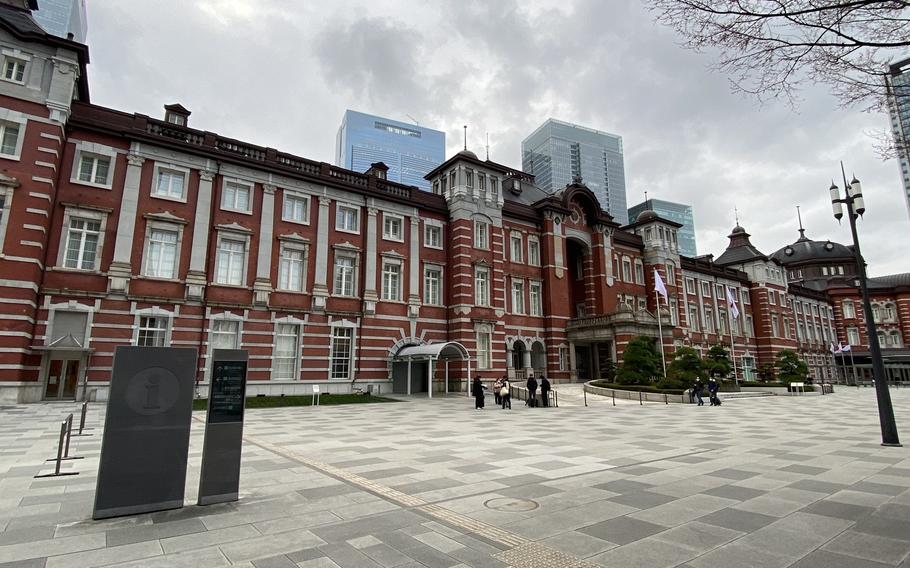
Tokyo Station (Photo by Takahiro Takiguchi)
Tokyo Station, constructed in 1914, is a major hub for commuters hopping on the Shinkansen or the Narita Express, but it is also known for an incredible view, as its Marunouchi side is illuminated from sunset until 9 p.m. every night. Take a nice walk along Miyuki (Gyoko) Street and Marunouchi Nakadori Street where the streetlights create an illuminated path from the Imperial Palace to the stunning Marunouchi façade of Tokyo Station. The classic buildings of old Japan blend in with the modern skyscrapers are a sight to marvel. The area also has plenty of restaurants and bars if you’re hungry or want to enjoy a pricey cocktail al fresco or up in some of the skyscraper lounges for a higher view.
Shimbashi, JY 29 – Watch video
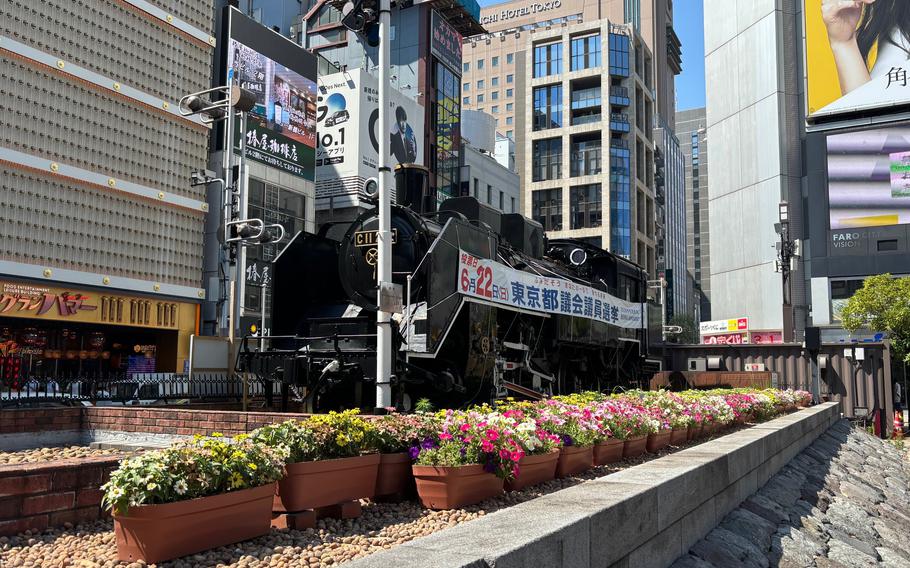
SL in front of Shimbashi Station ()
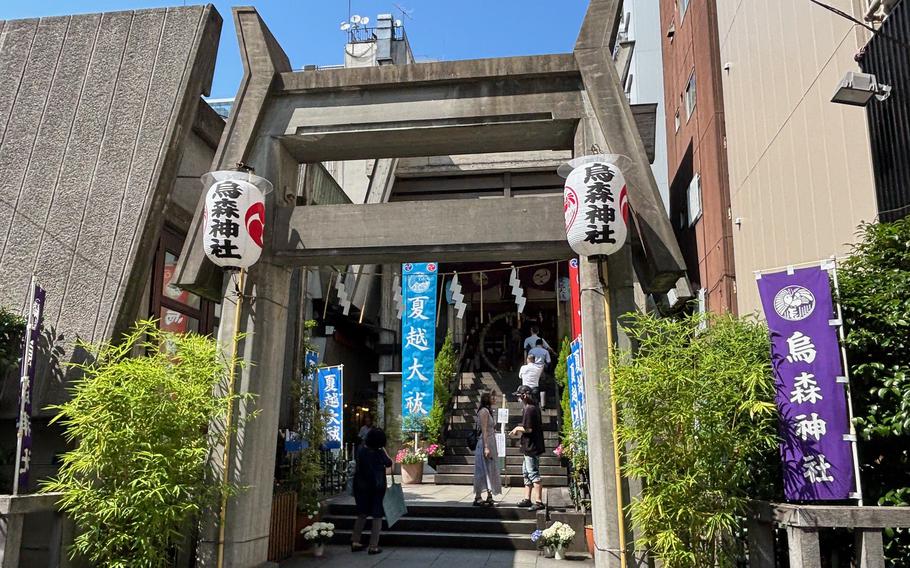
Karasumori Shrine (Photo by Takahiro Takiguchi)
Shimbashi Railway Museum (Photo by Takahiro Takiguchi)
Shimbashi in east Tokyo is considered a “salarymen’s sanctuary,” as the district boasts countless bars and eateries packed tightly in a small area surrounding its train station. Here you’ll also find Karasumori Jinja, a tiny Shinto shrine, nestled amongst all the activity. This is a lively area and often TV crews visit for colorful interviews with some of the salarymen about. For a more historical side of Shimbashi, visit the Old Shimbashi Station: Railway History Exhibition Hall, an exact replica of Meiji Era’s Shimbashi Station, the first railway terminal in Japan.
Shingawa, JY 25 – Read story
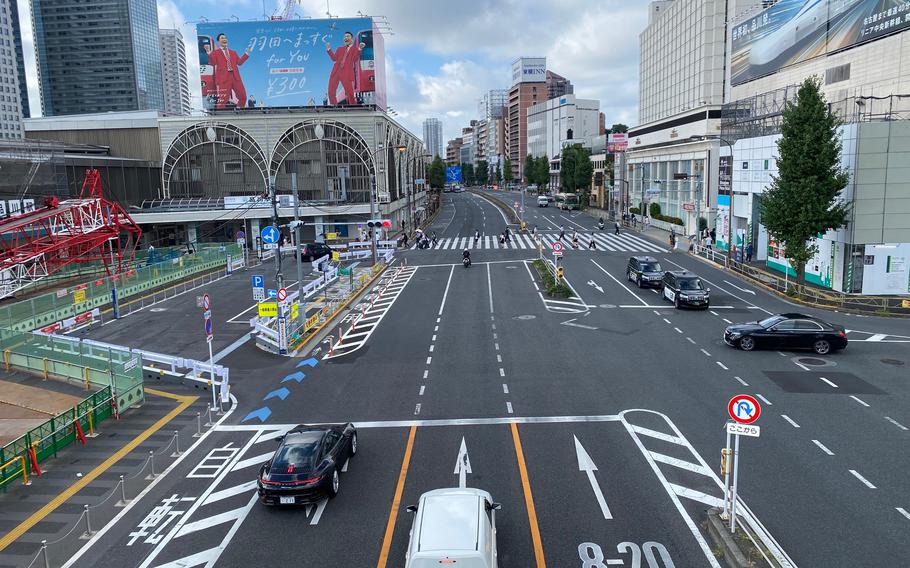
In front of Shingawa Station (Photo by Takahiro Takiguchi)
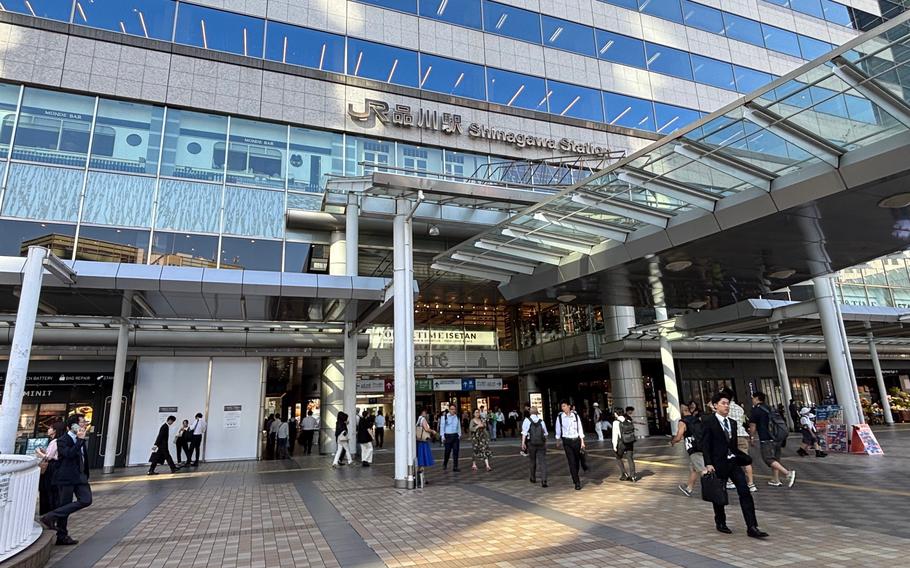
Shingawa Station (Photo by Takahiro Takiguchi)
With attractions that include a horse track, shrine, aquarium and waterfront brewery, Shinagawa makes for a great one-day trip for anyone looking to get off base and explore part of Japan. Located in Southeast Tokyo, many tourists would pass through or stay overnight in Shinagawa on their way to the big city. Nowadays, it is still an important gateway to Tokyo, as Shinagawa Station is one of Tokyo’s largest stations with 22 platforms for 8 railway lines including the bullet train. More than 530,000 passengers get on and off the trains at the station every day, including Tokyo salarymen on their way to work and tourists on their way to Kyoto, Osaka and other parts of western Japan.
Takanawa Gateway, JY 26 – Watch video
Takanawa Gateway (Photo by Takahiro Takiguchi)
Takanawa Gateway, the newest station of the JR Yamanote Line and Keihin Tohoku Line, opened in 2020 between the Tamachi and the Shinagawa stations. This station is an example of Japan’s old-meets-new aesthetic as it has traditional features blended with new technology. The station’s glass roof is coated with white fluorite resin to represent Japan’s washi paper. This unique design allows plenty of sunshine to elegantly illuminate the wooden interior. The wood-grain walls and tiles on the platform, staircases and restroom facilities give the commute a warm, Zen atmosphere. Take a 10-minute walk to Sengakuji Temple and pay respects to 47 samurai who are revered in Japan for their loyalty to their late master.
Akihabara, JY 03 – Watch video
(Photo by Takahiro Takiguchi)
(Photo by Takahiro Takiguchi)
Akihabara (“Akiba” for short) is one of the busiest districts in Tokyo, home to countless manga merch stores, electronic shops, unique cafes, game arcades and various other subcultures. The lively town is also known as a sanctuary for curry and ramen, as dozens of popular restaurants of those are packed in the area. Rajio Kaikan (or Radio Center) is home to dozens of small shops that offer new and antique radios and various parts, along with various gaming devices, videos and CDs at exceptionally low prices. Akihabara is also known for its unique cafés, such as cat and owl cafés, and other themed ones like Maid Cafés, where young women in classical western-style maid dresses welcome you with a greeting of “Okaerinasai goshujinsama!” (literally “Welcome back home, my lord!”).
Ueno, JY 05 – Watch video
Ameyoko (Photo by Takahiro Takiguchi)
Shinobazunoike Pond (Photo by Takahiro Takiguchi)
Takamori Saigo Statue at Ueno Park (Photo by Takahiro Takiguchi)
Ueno Park (Photo by Takahiro Takiguchi)
Ueno Zoo (Photo by Takahiro Takiguchi)
Ueno District is one of Tokyo’s busiest and has plenty of fun activities to fill an entire day. Here you’ll find Japan’s oldest zoo, more museums than you can visit in one day, a French-style modern park with a pond, Shinto shrines, Buddhist temples and busy streets with food and merchandise vendors. Every spring, the area draws thousands seeking to get a good view of the beautiful cherry blossoms in full bloom at Ueno Park. No matter the season, however, Ueno remains busy because it is also a train hub with over 17 platforms connecting local and far off domestic destinations.
Sugamo, JY 11 – Watch video
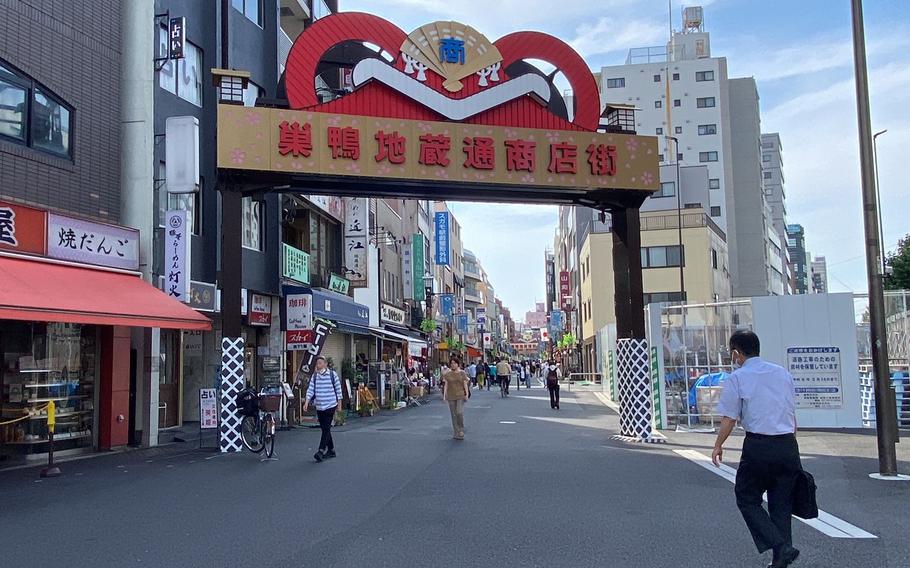
Sugamo Jizodori Shopping Street (Photo by Takahiro Takiguchi)
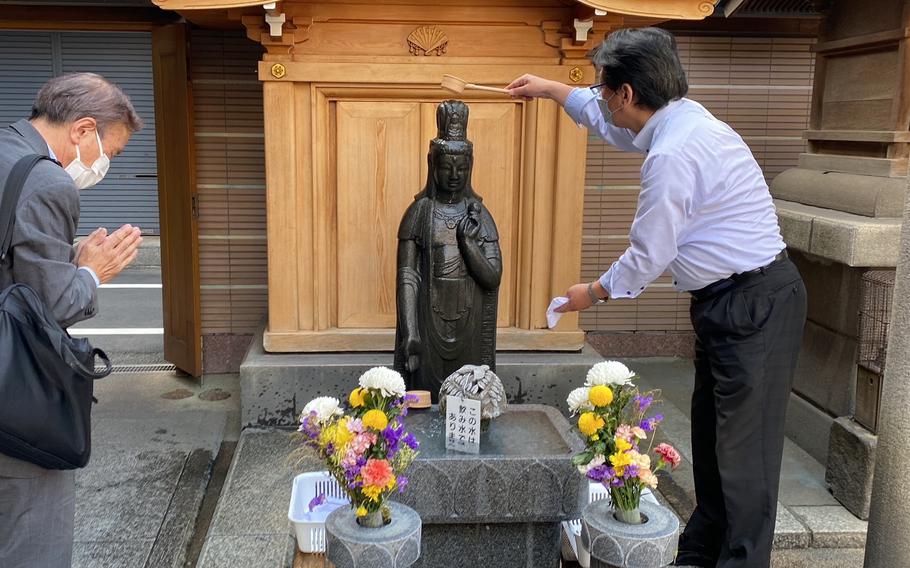
Sugamo – Arai Kannon (Photo by Takahiro Takiguchi)
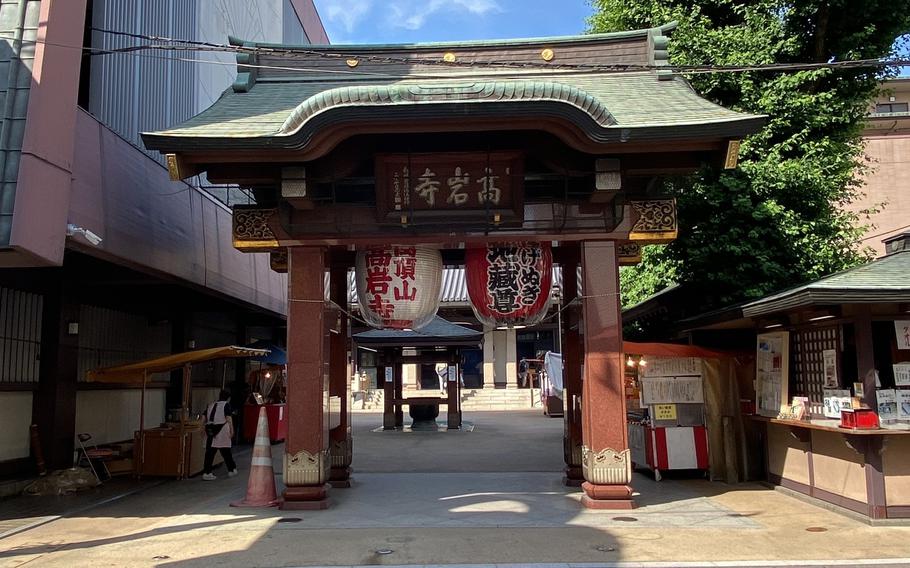
Sugamo Togenuki Jizo (Photo by Takahiro Takiguchi)
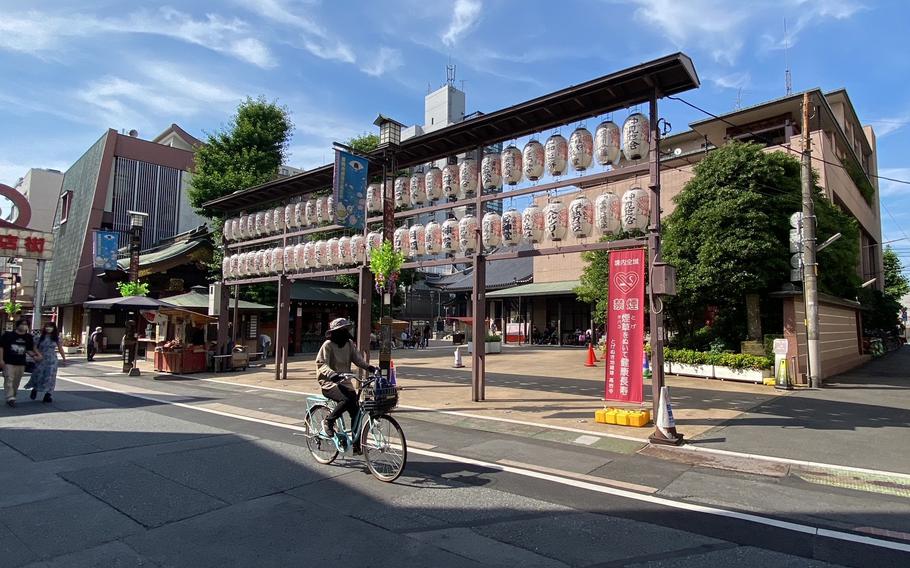
Sugamo Togenuki Jizo (Photo by Takahiro Takiguchi)
Sugamo is home to the well-known Jizodori Shopping Street frequented by senior citizens seeking clothes, health foods and souvenirs at over 200 shops. Its popularity amongst the elderly crowd has earned it the monikor of “Obaachan no Harajuku” (Grandma’s Harajuku). Tourists flock to the area to purchase red items, including undergarments, hand towels, keychains and more, as the items are said to help with good energy and circulation. On the street, Koganji, aka “Togenuki Jizoson,” is a Buddhist temple with a statue of Arai Kannon (literally, Washing Deity) believed to heal pains and sickness when you pour water on the it and use a cloth to polish the area corresponding to your own ailment.merchandise vendors. Every spring, the area draws thousands seeking to get a good view of the beautiful cherry blossoms in full bloom at Ueno Park. No matter the season, however, Ueno remains busy because it is also a train hub with over 17 platforms connecting local and far off domestic destinations.


AloJapan.com